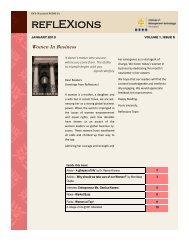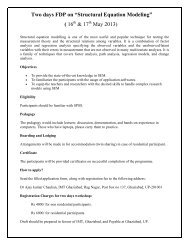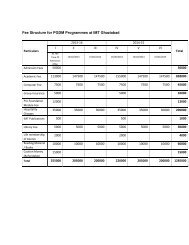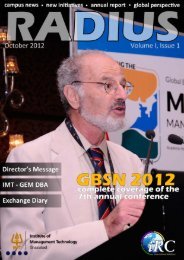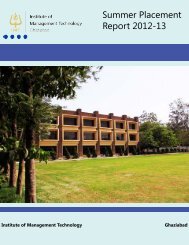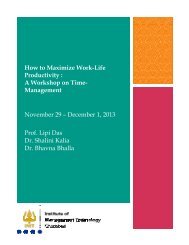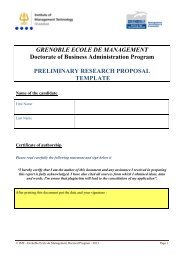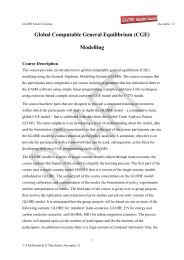You also want an ePaper? Increase the reach of your titles
YUMPU automatically turns print PDFs into web optimized ePapers that Google loves.
Volume 7 • Number 6 • June <strong>2013</strong><br />
Home About Us Archives Indexing/Abstracting Advertise Contact Us<br />
VOLUME 7 • NUMBER 6 • JUNE <strong>2013</strong><br />
AN EMPIRICAL STUDY ON THE BEHAVIOUR OF NIFTY INDEX BY EXAMINING THE DERIVATIVE CONTRACT<br />
Abstract:Indian Journal of Finance, Volume 7, Number 6, pp. 5 – 15<br />
The term "Derivative" indicates that it has no independent value, i.e. its value is entirely "derived" from the value of the underlying asset.<br />
The basic purpose of it is to transfer the price risk from one party to another, and mitigate the risk arising from the future uncertainty of<br />
prices. It is generally used as an instrument to hedge risk, but can also be used for speculative purpose. Prices in an organized derivatives<br />
market reflect the perception of the market participants about the future and lead the prices of the underlying to the perceived future<br />
level. This research is an attempt to find the efficiency of the sentimental indicators of financial derivatives in predicting the trend of the<br />
market (behaviour of NIFTY index). Participants in the stock markets believe that the amount of open interest (OI) in a particular contract<br />
has a bearing on the behavior of the price of the contract. This perception is put to test in the present research using the end of the day<br />
data (historical data) from August 2011 to February 2012, and examined the correlation between the cumulative percentage changes in<br />
open interest and cumulative percent change in the price of future contract of NIFTY index. The put-call ratio (PCR) is widely used by<br />
technical analysts as an indicator of the investor sentiment concerning future equity price trends. Many stock market experts cite the putcall<br />
ratio as an important indicator of investor sentiment, with a low (high) value indicating excessive optimism (pessimism). It is believed<br />
that the ratio is a useful contrarian indicator for future stock market behavior. In the present research paper, the value of the put-call<br />
ratio as an indicator of future stock market trend is put to test. The research is further extended towards application and analysis of the<br />
stock and option strategies in different market conditions and their pay-off using end of the day (EOD) data.<br />
Keywords: derivatives, put-call ratio, open interest, NIFTY, sentimental indicators<br />
JEL Classification: G13, G14<br />
References<br />
1 Bhuyan, R., & Chaudhury, M. (2001, October 4). “Trading on the Information Content of Open Interest: Evidence from the US Equity<br />
Options Market.” Working Paper, McGill University, pp.18-30.<br />
2 Chance, D. M., & Brooks, R. (2008). “Derivatives and Risk Management Basics.” Cengage Learning India Pvt. Ltd, New Delhi, pp. 183-<br />
207.<br />
3 Damodaran, A., & Lim, J. (1991). “The Effects of Option Listing on the Underlying Stocks' Return Processes.” Journal of Banking and<br />
Finance, 15 (3), pp. 647-664.<br />
4 Fodor, A., Krieger, K., & Doran, J. (2010). “Do Option Open-Interest Changes Predict Future Equity Returns” Thesis, Ohio University,<br />
University of Tulsa and Florida State University, pp. 265-280.<br />
5 Garag, A., & Ramesh, B. (2010). “Relationship between Futures Price and Open Interest in Stock and Index Futures in the Indian Stock<br />
Markets: Empirical Analysis.” International Conference on E-business, Management and Economics, IPEDR, Vol.3 (2011) © (2011)<br />
IACSIT Press, Hong Kong, pp.5 -8.<br />
6 Gupta, S. L. (2009). “Financial Derivatives: Theory, Concepts and Problems.” Prentice Hall of India Pvt. Ltd, pp. 173- 226.<br />
7 Hull, J. (2009). “Options, Futures and Other Derivatives.” 7th Edition, Prentice Hall India: New Delhi, pp. 197-216.<br />
8 Investopedia (2012). “ Definition of 'Put- Call Ratio.' ” Retrieved from http://www.investopedia.com/terms/p/putcallratio.asp<br />
9 Jorion, P. (2009). “Financial Risk Manager Handbook.” 5th Edition, John Wiley & Sons, Inc., Hoboken, New Jersey, USA, pp. 111-127.<br />
10 Kuo,W.-H., & Lin, T.-Y. (2011). “Does the Put-Call Ratio Forecast Market Returns Evidence from an Emerging Market.” International<br />
Research Journal of Finance and Economics, <strong>Issue</strong> 69, June, p. 95.<br />
11 Maniar, H., & Maniyar, D. (2008) .“Impact of Option Interest Information in Derivatives Markets- An Empirical Study of Stock Options<br />
Market, NSE.” International Conference MAF 2008, University of Ca' Foscari & University of Salerno, Italy.<br />
12 Mukherjee, K. N., & Mishra, R.K. (2004). “Impact of Open Interest and Trading Volume in Option Market on Underlying Cash Market:<br />
Empirical Evidence from Indian Equity Option Market.” Available at SSRN, Retrieved from http://ssrn.com/abstract=695745 or



